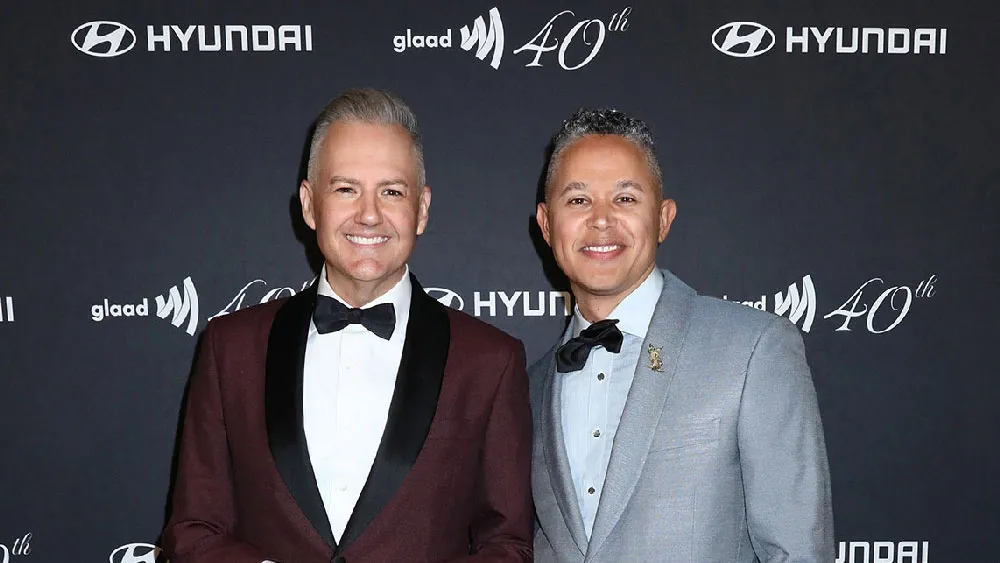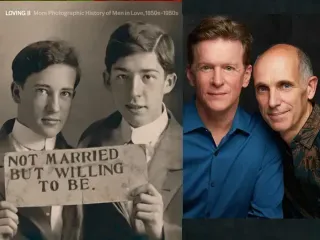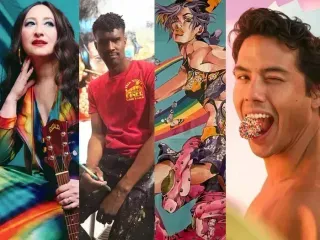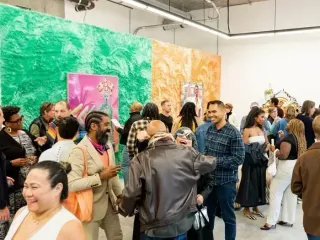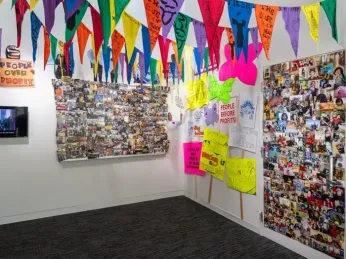
Oct 6
‘Makibaka: A Living Legacy’ – Queer Filipino-American artists resist erasure through art at YBCA
Myron Caringal READ TIME: 1 MIN.
At Yerba Buena Center for the Arts, the tagalog word makibaka (meaning “to struggle, to resist, and to defy”) stretches across the second-floor galleries, where more than 20 Filipino American artists reclaim space for memory, resilience, and belonging.
“Makibaka: A Living Legacy,” co-curated by SOMA Pilipinas and Trisha Lagaso Goldberg, runs through Jan. 4, 2026. The show lands at a poignant moment: October is both Filipino American History Month and LGBTQ+ History Month, and for the first time, SOMA Pilipinas is launching its own Pride celebration as part of that double observance.
At the crossroads of heritage, memory, and community, Bay Area-born and -raised artists Erina Alejo and JoJo Ty use their work to honor the people and places that shaped them. Both are featured in “Makibaka,” where their art continues a living lineage of care and resistance.
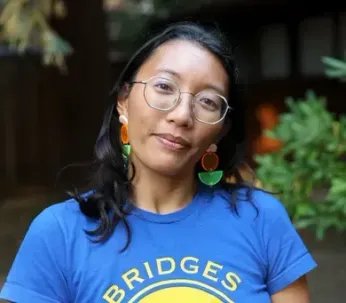
Remembering through archives
Alejo’s multimedia installation, “The Older I Get, The More I Remember,” layers student photographs taken in SOMA in 2017 with chalk inscriptions and archival references, inviting viewers into a dialogue with both the past and the future.
“These photographs examine faded memories, nostalgia, and also political events unfolding in SOMA and beyond,” Alejo said. “What seems to be fraught in the streets of South of Market actually nurtures soft and playful connections among the youth.”
Queerness, Alejo explained, is often an undercurrent rather than an overt theme in their work.
“I think a lot about the softness and the textures that I look at in my archives, and I think about the emotional vulnerability that I have,” they said. “Queerness is a framework in my artist practice.”
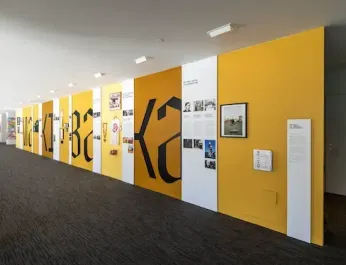
As a third-generation tenant in San Francisco, Alejo also frames renting itself as part of the city’s living history and a testament to tenacity.
Alejo doesn’t own a home in the city, “but it’s powerful that way,” they said. “We feel wealthy in our community.”
In “Makibaka,” Alejo’s piece becomes both archive and incantation, resisting what they call “cultural amnesia” and insisting on remembering tenderly, stubbornly, collectively.
Honoring queer and trans elders
For Ty, Makibaka offered a chance to honor their queer and trans ancestors whose contributions are too often overlooked. Their print in the show pays tribute to longtime community leader Nikki Calma, better known as Tita Aida (tagalog for “Aunty AIDS”), a San Francisco activist who’s been an advocate for HIV/AIDS awareness since the 1990s.
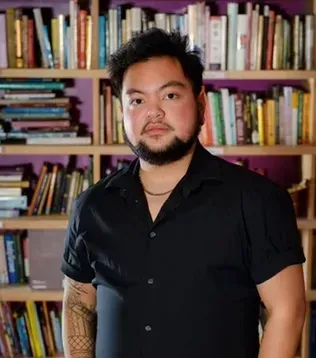
“I don't think there was any art made of her yet,” Ty said. “I created this print to bring awareness to her as well as highlight trans Filipino folks, too. Queer and trans Filipinos were always there, we’ve been a part of the community. But not until very recently are we finally getting our flowers.”
Ty came to art through activism, first organizing with LYRIC as a youth leader and later serving on the San Francisco Youth Commission and a part of the Mayor’s Office of Transgender Initiatives’ Advisory Committee. Previously, they co-ran a TGNC-owned café cooperative and event space in the Tenderloin. Currently, they do work for Queer Ancestors Project, a space that has facilitated their launch into community-based art.
“For me, art is never an isolated practice,” Ty said. “Being in community, learning stories, also doing my own research, going to the archives and talking with folks, I think those connections with people influence and push my art to practice.”
As a trans Filipino artist, Ty sees their existence as part of an ancestral continuum.
“Being trans and Filipino is about honoring and tapping into our ancestors, pre-Spanish colonizers: choosing our names, how we present ourselves, going beyond the binaries. Even resistance, taking up space, no longer wanting to hide in the closets, but also being honored.”
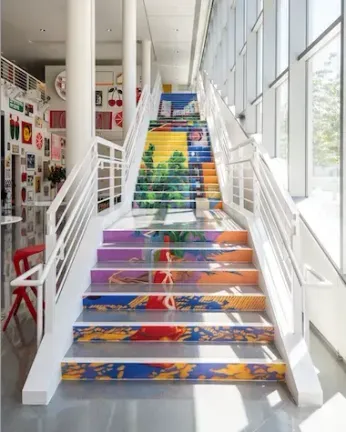
Pride as a marker of legacy
Though Alejo and Ty work in different media, both emphasize queerness as a method: a way of making that centers vulnerability, mutual care and collective memory. Alejo’s pedagogy leans on feminist, queer-informed study for young people; Ty speaks of art as a woven fabric where each thread is collective labor and love. Both highlight the need to document and honor queer Filipino elders and ancestors.
The idea that Filipino and queer presence is not symbolic but integral gives Makibaka its power. The exhibition stitches contemporary art to community archives and organizers like SOMCAN and Bindlestiff Studio, and it maps creative ecosystems that have long sustained San Francisco’s Filipino cultural district.
This October, SOMA Pilipinas’ inaugural Pride celebration, dubbed “Makibeki” (a playful twist on makibaka, with “beki” meaning “queer” in Filipino slang), will fold “Makibaka” into its programming. For Alejo, the festival marks an overdue acknowledgment of queer ancestral presence in the district. For Ty, it offers a moment to remind the community that visibility must come with solidarity.
“Y’all like to celebrate us,” Ty said, “but will you be there with us while grieving, while trying to heal? I hope folks who see Makibaka feel the love and care, and the work that our ancestors did, and are inspired to continue that work.”
Alejo echoed that sentiment, pointing to solidarity as essential amid mounting threats to queer and trans lives under government administration.
“That’s what’s going to get us through this really crappy time,” they said. “If we think about the resilience of Filipinos in the diaspora and the queer ancestors who have been fighting for our rights and our resilience, I think that’ll give us a lot of hope.”
As “Makibaka” stretches toward January, both artists see their contributions as seeds rather than epilogues. Ty hopes visitors leave feeling part of a woven fabric: each person a strand in a larger story of care and resistance.
“Reflect thoughtfully on these moments and think about the future, so that we're reminded of our own power and responsibility to resist cultural amnesia,” Alejo said. “To remember and feel with deep empathy.”
Their work insists that to fight is also to love: to hold memory with tenderness and to imagine otherwise. “Makibaka” makes that living legacy visible: queer and trans Filipino artists holding space for the past while shaping the future.
‘Makibeki: SOMA Pilipinas Pride.’ Sunday, Oct. 12 at Yerba Buena Center for the Arts, 701 Mission St. Free.
‘Makibaka: A Living Legacy,’ open through Jan. 4, 2026 at Yerba Buena Center for the Arts, 701 Mission St. Wed-Sun. 11am–5pm.
https://ybca.org/event/makibaka-a-living-legacy/
https://erinacalejo.com/
